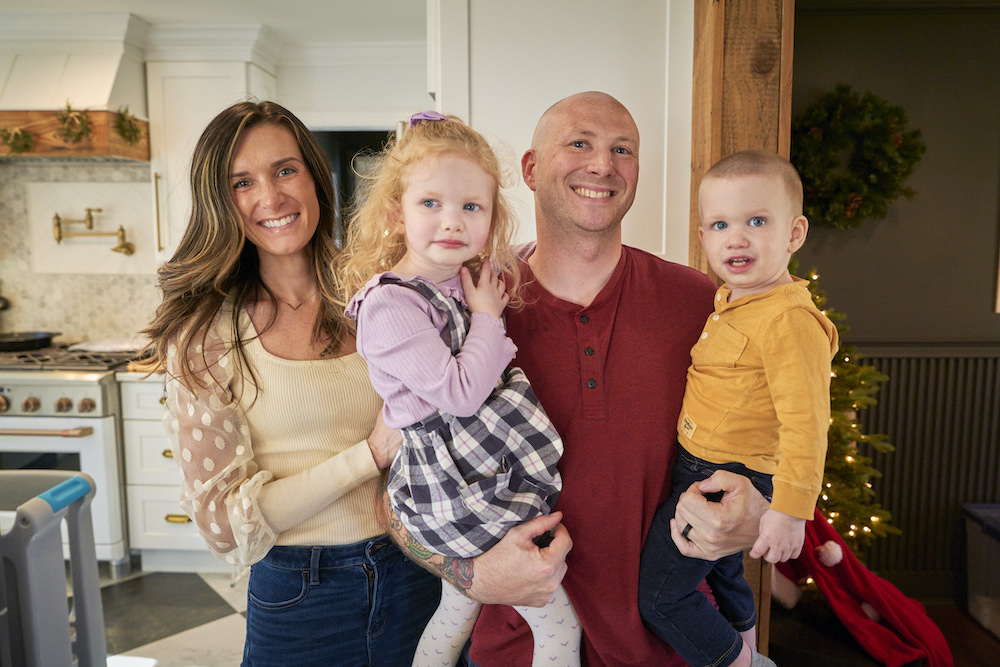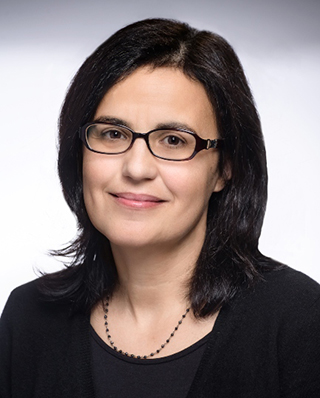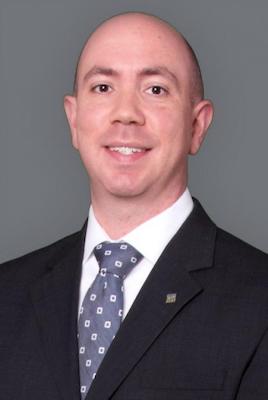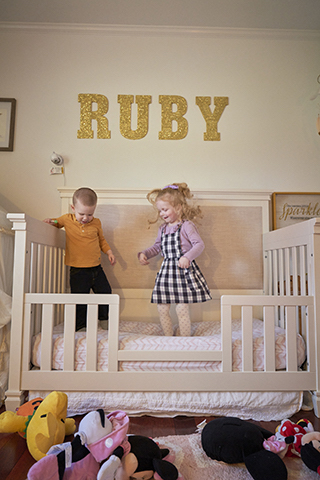Two Toddlers, Two Heart Transplants, Too Many Blessings To Count
The Cotter family shares their heartfelt gratitude for the gift of life that both their kids received — and the team at NewYork-Presbyterian Morgan Stanley Children’s Hospital who made it all possible.
It’s no surprise to Brian and Ashley Cotter when they catch their 23-month-old son Everett getting into the garbage can … again.
“He can open the garbage — and it’s not easy to open! — and he can pull the whole thing out,” says Ashley, laughing and shaking her head. “He’s a little jokester.”
Buddy, as he is more commonly known, is also “very loving. He’s full of hugs and kisses. He’s very joyful,” adds Brian. “It’s hard to believe that a few months ago we were living at the hospital, and how close he was to the other side.”
Whether Buddy spontaneously bursts into a chorus of “Baby Shark” or plays with blocks or his current favorite toy, a tube of sunblock, the Cotters see each explosion of rambunctious toddler energy in their Long Island, N.Y., home as a reminder of how far their son has come.
At 11 months, Buddy was diagnosed with dilated cardiomyopathy, a condition where the heart is enlarged and unable to pump blood efficiently through the body. After a six-month wait that was filled with some touch-and-go moments and plenty of emotionally daunting days, Buddy underwent a successful heart transplant at just 18 months old at NewYork-Presbyterian Morgan Stanley Children’s Hospital — with the same team who, more than two years ago, had performed a heart transplant on his big sister, Ruby, now 3.
Today, as the family of four prepares to celebrate Thanksgiving together, there is a bounty of blessings to savor. “Seeing the kids together for me has been the biggest blessing. It’s been very emotional, because for a long time we didn’t know if this would ever be something our family would experience,” says Ashley. “To see them both at home, it gives me a sense of peace.”
“I think about our experience [at NewYork-Presbyterian] all the time. I think about all the nurses and doctors and surgeons. It’s amazing how hard everybody works, and they truly care,” says Brian. “This isn’t an accident. This isn’t luck. This is because of really good people.”

Ashley, Ruby, Brian, and Buddy are grateful to be together this Thanksgiving.
“It Was Déjà Vu”
Around Thanksgiving last year, Buddy was a little off. “He started acting funny,” recalls Ashley. “We thought he had a cold. He was sleeping a lot and a little congested.”
Doctors discovered that Buddy had rhinovirus, but as the days passed, his symptoms didn’t improve. By day six, he was getting worse and started to vomit,” says Ashley. “At one point in the night, he was just doing this groaning scream. We knew something was not right, so we brought him to the ER.”
Doctors immediately hooked Buddy up to an IV and provided supplemental oxygen as they ran a gamut of tests until X-rays revealed that Buddy’s heart was enlarged.

Dr. Irene Lytrivi
“I felt all the blood leave my body. It was an out of body experience. It felt like I was watching us through a window going through the same exact thing we did with our daughter,” says Ashley. “It was déjà vu.”
Three years earlier, the couple stood in the same emergency room when their 10-week-old daughter, Ruby, was diagnosed with the same condition. The rare heart disease, which is thought to be caused by a genetic predisposition or a viral infection, only affects about 4 in 100,000 infants under 12 months.
The Cotters had checked Buddy’s heart when he was born, and everything appeared normal. But when Buddy started experiencing symptoms similar to Ruby’s, “my husband just had this gut feeling, and that’s why we took him to the ER,” says Ashley.
The Cotters’ local hospital quickly transferred Buddy to NewYork-Presbyterian Morgan Stanley Children’s Hospital, where Ruby received her heart transplant in December 2019. “I called the heart failure team [at Morgan Stanley Children’s Hospital] and I was like, ‘My son has heart failure, we’re coming to you,’” recalls Ashley. “We had no question in our mind that we were going to NewYork-Presbyterian for care.”
Within 24 hours of arriving at NewYork-Presbyterian Morgan Stanley Children’s Hospital, Buddy went into cardiac arrest, and doctors swiftly put him on extracorporeal membrane oxygenation (ECMO), an external life support machine that uses a pump to circulate blood through an artificial lung back into the bloodstream, to stabilize his failing heart.
“It didn’t feel real,” says Ashley of the early days in the hospital with Buddy. But it was clear that Buddy was going down the same path as his sister, Ruby. “There really wasn’t a question anymore. We knew he needed a heart transplant.”
“He was very sick. He had an irregular heart rhythm and very bad ventricular function,” says Dr. Irene Lytrivi, a pediatric cardiologist in the Program for Pediatric Cardiomyopathy, Heart Failure, and Transplantation at NewYork-Presbyterian Morgan Stanley Children’s Hospital and Ruby and Buddy’s doctor. “[Brian and Ashley] were totally shellshocked. This is a young, healthy couple. Nothing would point to this sequence of events. But they’re amazing parents. And they showed that the first time and the second time around.”
The Same, but Different
Despite having lived through the emotional highs and lows of caring for Ruby before and after her heart transplant, Brian and Ashley often found themselves navigating new scenarios and emotions with Buddy. “Every time we thought we knew what was going on because of our previous experience with Ruby, our son threw us a curveball,” says Ashley. “The only ways they were similar was the wait and knowing the surgery that you’re waiting for.”
The wait for a pediatric heart transplant often takes from four to six months, so to support the function of Buddy’s weakened heart, he needed a ventricular assist device (VAD). While Ruby had used a Berlin Heart, an external pump that maintains blood flow in babies with severe heart failure, Buddy had another option. Because he was older and bigger, Buddy qualified for a clinical trial for the pediatric Jarvik Heart, a new, less cumbersome device that is implanted in the chest. It afforded him more flexibility and freedom to move and experience key milestones during his time in the hospital.

Buddy celebrated his 1st birthday at NewYork-Presbyterian Morgan Stanley Children’s Hospital last year.
“He thrived with the VAD,” says Dr. Lytrivi, who is also an associate professor of pediatrics at Columbia University Vagelos College of Physicians and Surgeons. “He started walking and talking, and he was very engaged with physical therapy and with all of us.”
“Everyone loved him! He was always happy to see nurses and anyone who came into the room,” says Ashley. “He was getting stronger every day. He started eating solid foods, and we were like ‘OK, we can get through this.’”
But after four months on the Jarvik Heart, Buddy started hitting more hurdles. He was growing, but his heart was weakening. On top of that, he had to fight off two viruses. “We were tired and drained and doing our best to stay on top of his treatments,” says Brian. “It got pretty rough the last few months.”
“It was a little scary,” says Ashley, “because we were worried he wasn’t going to make it to the transplant.”
Relief and Release
On the morning of June 10, Brian was at the hospital eating breakfast and watching Mickey Mouse Clubhouse with Buddy when he noticed a group of doctors congregating by his son’s room. Dr. Marc Richmond, director of the Program for Pediatric Cardiomyopathy, Heart Failure, and Transplantation at NewYork-Presbyterian Morgan Stanley Children’s Hospital, delivered the good news the Cotter family had been waiting for: There was a donor heart for Buddy.

Dr. Marc Richmond
“I let out a tear of relief and then FaceTimed my wife,” says Brian. “I turned the phone around, and once she saw all the people in the room, she automatically knew what was going on.”
“Our reaction was release and excitement because we knew we would be together as a family again very, very soon,” says Ashley.
Their confidence was boosted when they learned that the same surgeon who performed Ruby’s transplant — Dr. David Kalfa, a pediatric and congenital cardiac surgeon at NewYork-Presbyterian and associate professor of surgery and surgical director of the Initiative for Pediatric Cardiac Innovation at Columbia University Vagelos College of Physicians and Surgeons — would also be in the operating room with Buddy.
“You’re definitely scared your child is going to undergo such a wild surgery,” says Brian. “But Dr. Kalfa is beyond human to us. Knowing that our kid was in his hands and he had already done an amazing job with Ruby, I felt great.”
In the early morning hours of June 11, Buddy received the gift of life during an eight-hour surgery. Within two days of the surgery he was off the ventilator, and two weeks later he was ready to go home.
“His recovery has been absolutely remarkable,” says Ashley. “We hope one day to be able to meet the families who selflessly thought of someone else to save our children. We are so grateful for them.”
All About the Jarvik Heart
Buddy took part in the PumpKIN (Pumps for Kids, Infants, and Neonates) clinical trial, funded by the National Heart, Lung, and Blood Institute, for the pediatric Jarvik Heart. The Jarvik Heart is a ventricular assist device (VAD) that is implanted in the chest cavity with only a single wire coming out to connect to the portable controller and power source. Compared to the Berlin Heart that Ruby had, which is an external pump that requires a lot of tubes and a minifridge-sized controller, the Jarvik “allowed Buddy to thrive while waiting for a heart donor,” says Dr. Richmond. “Ashley, Brian, and our entire team were all able to watch him develop as normally as possible during that time.”
The device is designed to lower the risk of complications such as stroke, commonly seen in children with VADs. Buddy was only the eighth child in the United States to receive the Jarvik Heart, and the second patient at NewYork-Presbyterian. During his hospital stay, Buddy was able to take his first steps, participate in Easter egg hunts on the hospital floor, and even go for short walks outside. With the Berlin Heart, “Ruby never left the bed,” says Ashley, “but he was able to do so much more.” Says Dr. Richmond, “By participating in this clinical trial, the Cotters were able to pay it forward. Data from Buddy and other participants will inform how we treat children in the future who require VADs.”
Sibling Reunion (and Rivalry)
This past summer, the siblings, who had spent months apart with Buddy in the hospital, were finally reunited.
“When we came home from the hospital with Buddy, they went to his room together and played. Within five to 10 minutes, they were arguing over toys!” says Brian, laughing. “Ruby is very used to her alone time and doing things her own way. But she’s getting better.”

After spending nearly seven months apart, Buddy and Ruby are happily reunited and playing together at home.
Overall, Brian adds, “I was very impressed with how they came back together after almost seven months apart. All the FaceTime we did actually worked!”
Buddy’s adjustment to home has been quick — and eventful. “Two days after being home, he had already walked around the entire house and started climbing on the couch,” says Ashley. The tough-but-tender toddler, who loves to wrestle with his sister and Dad, “loves his family,” says Brian. “I don’t think Buddy has an angry or evil bone in his body.”
There are a few mischievous ones, though. “His big thing right now is opening and closing doors,” says Ashley. “It’s very funny, because you tell him no a million times, and he just looks at you with a devilish look in his eye. He’s like, “Oh, I’m going to close this door anyway.’”
Lately, however, Brian and Ashley feel like doors are opening for their whole family.
“Being a heart family is empowering because of how normal we’ve made our life after two of our children had heart transplants,” says Brian.
Whether Ruby is celebrating her first day of pre-K or the kids are chasing the family’s boxer, Jody, and corgi, Syrah, around the house, “there’s something so special to every moment when you’ve dealt with the feeling of possibly losing [your kids] that when you see them doing normal things, it’s just incredible,” says Brian. “They’re little superheroes, both of them.”
